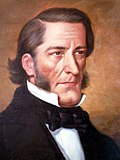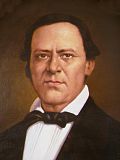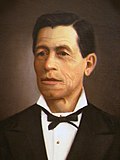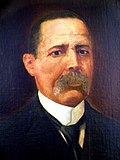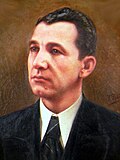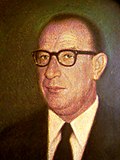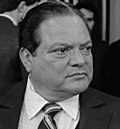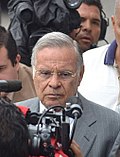No. President (Birth–Death) Term of office Political affiliation Election Notes 1 José María Castro Madriz (1818–1892) 31 August 1848 [ 1] 16 November 1849 Non-partisan Liberal 1847 "Founder of the Republic". (1) Miguel Mora Porras (1816–1887) 16 November 1849 26 November 1849 Non-partisan Liberal Interim president. 2 Juan Mora Porras (1814–1860) 26 November 1849 14 August 1859 Non-partisan Liberal 1849 1853 1859 First, second and third term. 3 José María Montealegre Fernández (1815–1887) 14 August 1859 8 May 1863 Non-partisan Liberal 1860 Provisional 1859–1860. 4 Jesús Jiménez Zamora (1823–1897) 8 May 1863 8 May 1866 Non-partisan Liberal 1863 5 José Castro Madriz (1818–1892) 8 May 1866 1 November 1868 Non-partisan Liberal 1866 Second term. Deposed in a coup d'état. 6 Jesús Jiménez Zamora (1823–1897) 1 November 1868 27 April 1870 Military De facto Second term. 7 Bruno Carranza Ramírez (1822–1891) 27 April 1870 8 August 1870 Non-partisan Liberal Appointed by Tomás Guardia as provisional president. Resigned after a few months. 8 Tomás Guardia Gutiérrez (1831–1882) 10 August 1870 8 May 1876 Non-partisan Liberal 1872 Provisional 1870–1872, latter elected. 9 Aniceto Esquivel Sáenz (1824–1898) 8 May 1876 30 July 1876 Non-partisan Liberal 1876 Deposed in a coup d'état. 10 Vicente Herrera Zeledón (1821–1888) 30 July 1876 11 September 1877 Non-partisan Conservative Appointed by Guardia. 11 Tomás Guardia Gutiérrez (1831–1882) 11 September 1877 6 July 1882 Non-partisan Liberal Second term as de facto ruler. Died in office. 12 Saturnino Lizano Gutiérrez (1826–1905) 6 July 1882 20 July 1882 Non-partisan Liberal Acting president. 13 Próspero Fernández Oreamuno (1834–1885) 20 July 1882 12 March 1885 Non-partisan Liberal 1882 Died in office. 14 Bernardo Soto Alfaro (1854–1931) 12 March 1885 8 May 1890 Non-partisan Liberal 1886 Two consecutive terms, the first incomplete. Carlos Durán Cartín was acting president 1889–1890. 15 José Rodríguez Zeledón (1837–1917) 8 May 1890 8 May 1894 Constitutional Democratic 1889 16 Rafael Yglesias Castro (1861–1924) 8 May 1894 8 May 1902 Civil 1894 1897
First and second term. 17 Ascensión Esquivel Ibarra (1844–1923) 8 May 1902 8 May 1906 National Union 1902 18 Cleto González Víquez (1858–1937) 8 May 1906 8 May 1910 National 1906 First term. 19 Ricardo Jiménez Oreamuno (1859–1945) 8 May 1910 8 May 1914 Republican 1910 First term. Son of Jesús Jiménez Zamora . 20 Alfredo González Flores (1877–1962) 8 May 1914 27 January 1917 Republican Designated by Congress as no clear candidate won in 1913 De facto Deposed by Tinoco in a coup d'état . 21 Federico Tinoco Granados (1868–1931) 27 January 1917 13 August 1919 Peliquista Took power after coup, was sole candidate in the 1917 election First and second term. Overthrown by popular uprising. 22 Juan Quirós Segura (1853–1934) 13 August 1919 2 September 1919 Peliquista De facto Previously Vice President . Replaced Tinoco after his escape. Forced to resign by the U.S. government. 23 Francisco Aguilar Barquero (1857–1924) 2 September 1919 8 May 1920 Republican Interim president. 24 Julio Acosta García (1872–1954) 8 May 1920 8 May 1924 Constitutional 1919 25 Ricardo Jiménez Oreamuno (1859–1945) 8 May 1924 8 May 1928 Republican 1923 Second term. 26 Cleto González Víquez (1858–1937) 8 May 1928 8 May 1932 National Union 1928 Second term. 27 Ricardo Jiménez Oreamuno (1859–1945) 8 May 1932 8 May 1936 National Republican 1932 Third term. 28 León Cortés Castro (1882–1946) 8 May 1936 8 May 1940 National Republican 1936 29 Rafael Calderón Guardia (1900–1970) 8 May 1940 8 May 1944 National Republican 1940 30 Teodoro Picado Michalski (1900–1960) 8 May 1944 20 April 1948 National Republican 1944 (31a) Santos León Herrera (1874–1950) 20 April 1948 8 May 1948 National Republican Interim president. Former vice-president of Teodoro Picado Michalski. (31b) José Figueres Ferrer (1906–1990) 8 May 1948 8 November 1949 Social Democratic De facto Came to power in the Civil War . Returned power to elected president after re-organizing the government. 31 Otilio Ulate Blanco (1891–1973) 8 November 1949 8 November 1953 National Union 1948 32 José Figueres Ferrer (1906–1990) 8 November 1953 8 May 1958 National Liberation 1953 Second term. Presidential re-election disallowed. 33 Mario Echandi Jiménez (1915–2011) 8 May 1958 8 May 1962 National Union 1958 34 Francisco Orlich Bolmarcich (1907–1969) 8 May 1962 8 May 1966 National Liberation 1962 35 José Trejos Fernández (1916–2010) 8 May 1966 8 May 1970 National Unification 1966 36 José Figueres Ferrer (1906–1990) 8 May 1970 8 May 1974 National Liberation 1970 Third term. Presidential re-election disallowed. 37 Daniel Oduber Quirós (1921–1991) 8 May 1974 8 May 1978 National Liberation 1974 38 Rodrigo Carazo Odio (1926–2009) 8 May 1978 8 May 1982 Unity Coalition 1978 39 Luis Monge Álvarez (1925–2016) 8 May 1982 8 May 1986 National Liberation 1982 40 Óscar Arias Sánchez (born 1940) 8 May 1986 8 May 1990 National Liberation 1986 Nobel Peace Prize winner (1987). 41 Rafael Calderón Fournier (born 1949) 8 May 1990 8 May 1994 Social Christian Unity 1990 Son of Rafael Ángel Calderón Guardia . 42 José Figueres Olsen (born 1954) 8 May 1994 8 May 1998 National Liberation 1994 Son of José Figueres Ferrer . 43 Miguel Rodríguez Echeverría (born 1940) 8 May 1998 8 May 2002 Social Christian Unity 1998 44 Abel Pacheco de la Espriella (born 1933) 8 May 2002 8 May 2006 Social Christian Unity 2002 Presidential re-election re-instated. 45 Óscar Arias Sánchez (born 1940) 8 May 2006 8 May 2010 National Liberation 2006 Second term. 46 Laura Chinchilla Miranda (born 1959) 8 May 2010 8 May 2014 National Liberation 2010 First female president of Costa Rica. [ 2] 47 Luis Guillermo Solís Rivera (born 1958) 8 May 2014 8 May 2018 Citizens' Action 2014 48 Carlos Alvarado Quesada (born 1980) 8 May 2018 8 May 2022 Citizens' Action 2018 Youngest president since Alfredo González Flores (1914). First president to be called by Congress for hearing. 49 Rodrigo Chaves Robles (born 1961) 8 May 2022 Incumbent(Term ends on 8 May 2026 ) Social Democratic Progress 2022 Incumbent 

